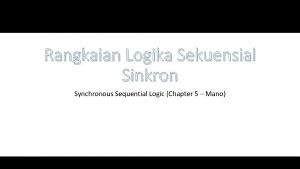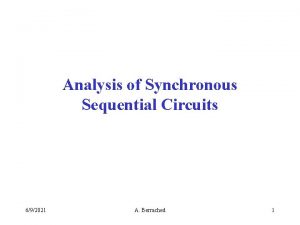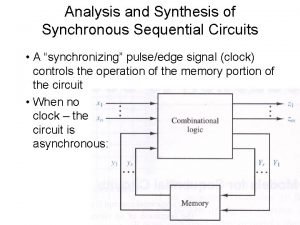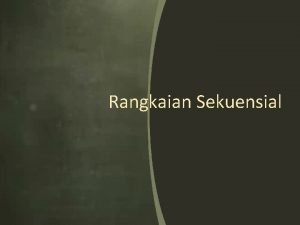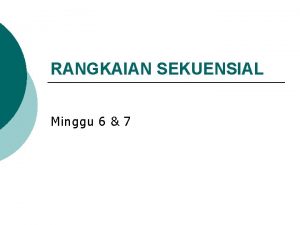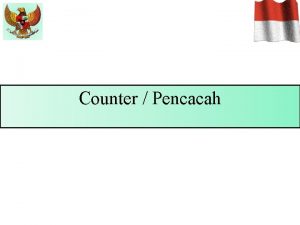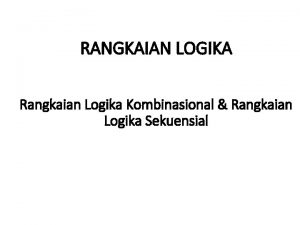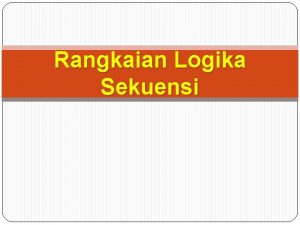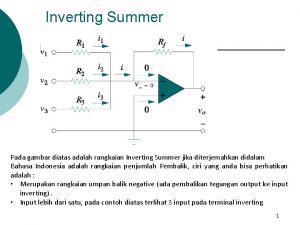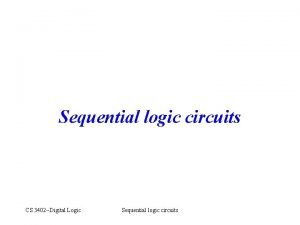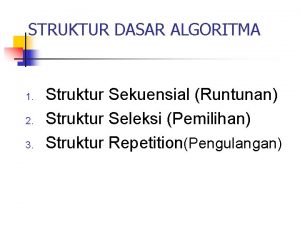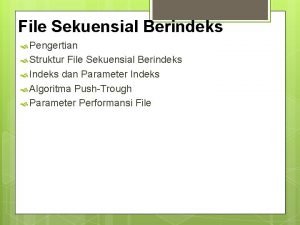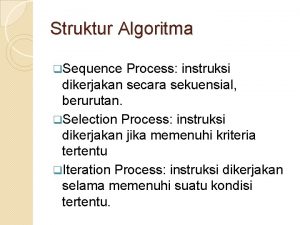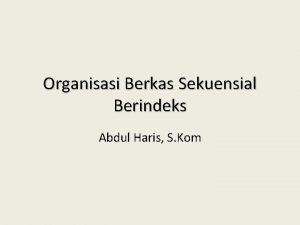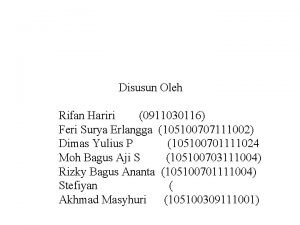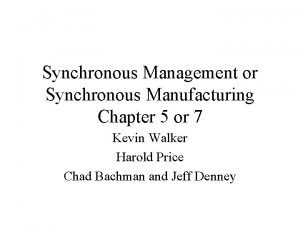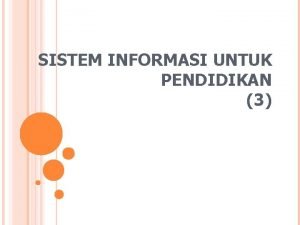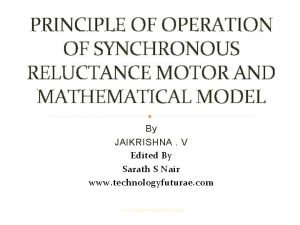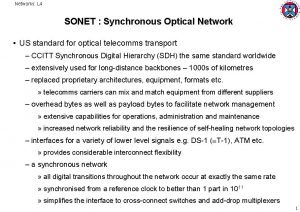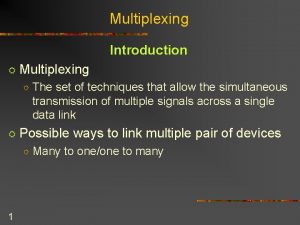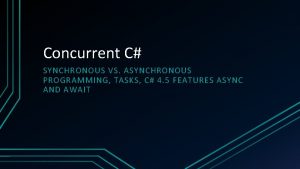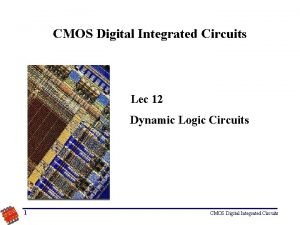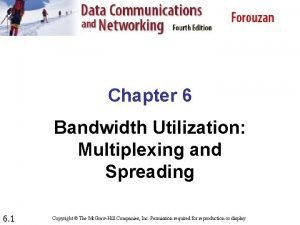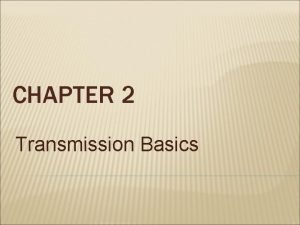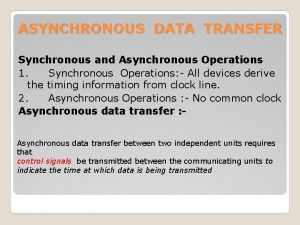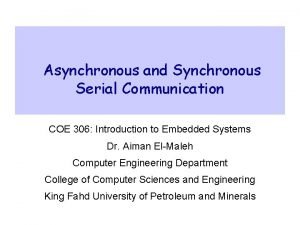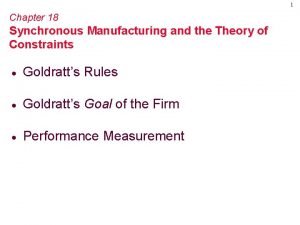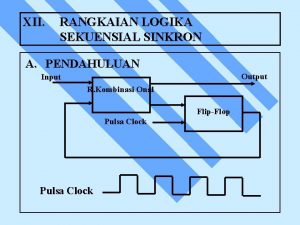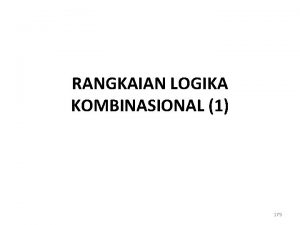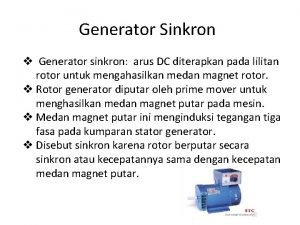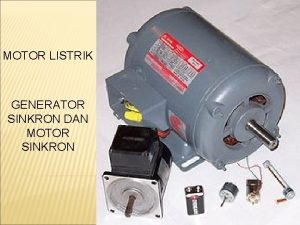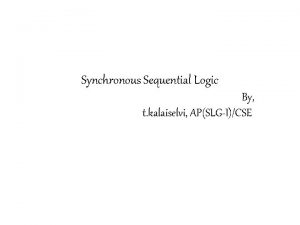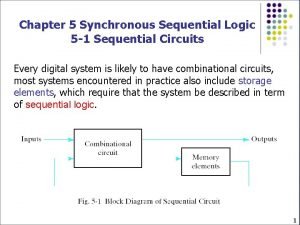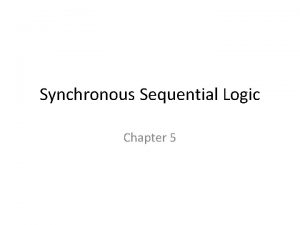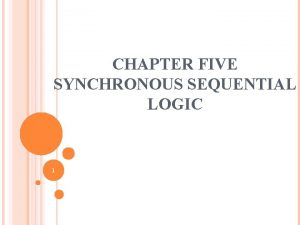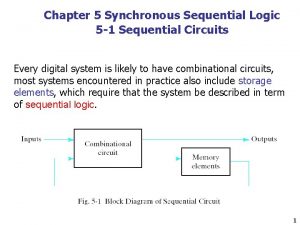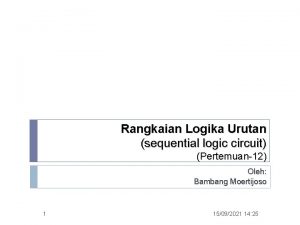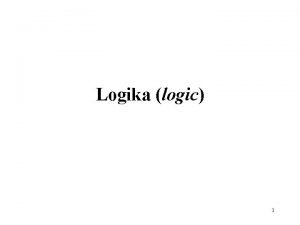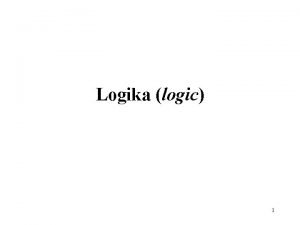Rangkaian Logika Sekuensial Sinkron Synchronous Sequential Logic Chapter



























































- Slides: 59

Rangkaian Logika Sekuensial Sinkron Synchronous Sequential Logic (Chapter 5 – Mano)

Combinational v. s Sequential Logic Combinational Logic: Sequential Logic: • Output hanya tergantung dari kombinasi input saat itu • Dapat digunakan untuk berbgai operasi (add/subtract/multiply/en code/decode/select[mux] /etc…) • Perlu mengkombinasikan berbagai strukutur secara tersusun • Tidak fleksibel dan lebih mahal • Output tergantung dari input saat itu dan juga output sebelumnya • Dapat menyimpan informasi antar operasiopearasi • Memerlukan beberapa jenis memory (disebut sbg Register) untuk mengingat nilai output sebelumnya. (Biasanya menggunakan D Flip Flop sebagai Registers)

Logika Sekuensial

Logika Sekuensial • Sequential Logic circuits remember past • inputs and past circuit state. • Outputs from the system are“fed back” as new inputs. • The memory elements are circuits that are capable of storing binary information

Sinkron v. s Asinkron There are two types of sequential circuits: • Synchronous sequential circuit: Output berubah pada waktu-waktu tertentu. Penentuan waktu menggunakan sinyal timing yang disebut sebagai clock. • Asynchronous (fundamental mode) sequential circuit: Output berubah setiap saat tergantung pada urutan perubahan sinyal input. Rangkain ini tidak memerlukan clock (clockless).

Logika Sekuensial Sinkron

Pulsa Clock Positive pulses Positive edges Negative edges

Latches dan Flip-Flop § Multivibrator: jenis rangkaian sekuensial. Ada 3 jenis: vbistable (2 kondisi) vmonostable or one-shot (1 kondisi stabil) vastable (tidak ada kondisi stabil, selalu berubah) § Bistable logic devices: latches dan flip-flops. § Latches dan flip-flop berbeda dalama hal bagaimana cara perubahan state-nya

Memory Elements § Memory element: Sebuah perangkat yang dapat mengingat nilai sebelumnya atau mengubah nilai berdasarkan perintah(command) dari inputnya. command Memory element Q stored value § Characteristic table: Q(t): kondisi sekarang Q(t+1) atau Q+: state berikutnya 9

Memory Elements § Ada dua cara untuk mentriger atau mengatifkan elemen: vpulse-triggered (Berdasar nilai pulsanya: 1 atau 0) vedge-triggered (berdasarkan perubahan nilai pulsanya: berubah dari 1 menjadi 0 atau dari 0 menjadi 1) § Jenis Pulse-triggered : Latches v. ON = 1, OFF = 0 § Jenis Edge-triggered : flip-flops vpositive edge-triggered (ON = dari 0 ke 1; OFF = selain kondisi ON) vnegative edge-triggered (ON = dari 1 ke 0; OFF = selain kondisi ON)

LATCHES : SR Latch • S-R (set reset) LATCH Versi NOR Gate (SR Latch) Q=1 disebut 'Set State' Q=0 disebut 'Reset State'

LATCHES: SR Latch • S-R (set reset) LATCH Versi NAND Gate (S'R' Latch) Q=1 disebut 'Set State' Q=0 disebut 'Reset State'

• S-R Latch dengan Pengontrol Input X = Don't Care, Kondisi apapun: boleh 0 atau pun 1

LATCHES: D-LATCH • Dengan memberikan S=D sedangkan R=D' maka dapat menghindarkan kondis S=1 dan R=1 S R SR - Latch dengan Control Input

Simbol Latch SR Latch Versi NOR SR Latch Versi NAND D - Latch

LATCH BEHAVIOUR AND ISSUES • Level triggered • Latches are “transparent” (= any change on the inputs is seen at the outputs immediately). • This causes synchronization problems! (not recommended for use in synchronous designs) • Solution: use latches to create flip-flops that can respond (update) ONLY on SPECIFIC times (instead of ANY time).

Flip-Flops • Flip-flop bekerja mirip dengan Latch hanya saja ditriger secara edgetrigerred • Respon Terhadap Clock (a) Untuk Latch (b-c) untuk Flip-flop:

Edge-Triggered Flip-flops § Flip-flops: synchronous bistable devices § Output changes state at a specified point on a triggering input called the clock. § Change state either at the positive edge (rising edge) or at the negative edge (falling edge) of the clock signal. Clock signal Positive edges Negative edges

Edge-Triggered Flip-flops § S-R, D and J-K edge-triggered flip-flops. Note the “>” symbol at the clock input. S C R Q D C Q' Q Q' J C K Q Q' Positive edge-triggered flip-flops S C R Q Q' D C Q Q' Negative edge-triggered flip-flops Q'

Tugas • Buat tulisan tentang: • • SR - Flip Flop D - Flip Flop JK - Flip FLop T- Flip FLop • Tulisan Meliputi • Rangkaian/ Blok Rangkaian • Cara kerja dan tabel kebenaran

S-R Flip-flop § S-R flip-flop: on the triggering edge of the clock pulse, v. S=HIGH (and R=LOW) a SET state v. R=HIGH (and S=LOW) a RESET state vboth inputs LOW a no change vboth inputs HIGH a invalid § Characteristic table of positive edge-triggered S-R flipflop: X = irrelevant (“don’t care”) = clock transition LOW to HIGH

S-R Flip-flop § It comprises 3 parts: va basic NAND latch va pulse-steering circuit va pulse transition detector (or edge detector) circuit § The pulse transition detector detects a rising (or falling) edge and produces a very short-duration spike.

S-R Flip-flop The pulse transition detector. S Q Pulse transition detector CLK Q' R CLK' CLK CLK* CLK CLK' CLK* Positive-going transition (rising edge) SR Flip-flop Negative-going transition (falling edge)

D Flip-flop § D flip-flop: single input D (data) v. D=HIGH a SET state v. D=LOW a RESET state § Q follows D at the clock edge. § Convert S-R flip-flop into a D flip-flop: add an inverter. D CLK S C R Q Q' A positive edge-triggered D flip-flop formed with an S-R flip-flop. D Flip-flop = clock transition LOW to HIGH 24

D Flip-flop § Application: Parallel data transfer. To transfer logic-circuit outputs X, Y, Z to flip-flops Q 1, Q 2 and Q 3 for storage. D CLK X Combinational logic circuit Y D Z CLK D Transfer CLK Q Q 1 = X* Q' Q Q 2 = Y* Q' Q Q 3 = Z* Q' * After occurrence of negative-going transition D Flip-flop 25

J-K Flip-flop § J-K flip-flop: Q and Q' are fed back to the pulsesteering NAND gates. § No invalid state. § Include a toggle state. v. J=HIGH (and K=LOW) a SET state v. K=HIGH (and J=LOW) a RESET state vboth inputs LOW a no change vboth inputs HIGH a toggle J-K Flip-Ffop 26

J-K Flip-flop § J-K flip-flop. J CLK Pulse transition detector K Q Q' § Characteristic table. Q(t+1) = J. Q' + K'. Q J-K Flip-flop 27

T Flip-flop § T flip-flop: single-input version of the J-K flip flop, formed by tying both inputs together. T CLK T Q Pulse transition detector CLK Q' J C K Q Q' § Characteristic table. Q(t+1) = T. Q' + T'. Q T Flip-flop 28

T Flip-flop § Application: Frequency division. High J CLK High J Q CLK C K CLK Q QA QA J C C K K QB QB Divide clock frequency by 2. Divide clock frequency by 4. § Application: Counter T Flip-flop 29


Analysis of Clocked Sequential Circuits : State • State (Keadaan) • State = Nilai output semua flip-flop Contoh AB=00 Keluaran dari dua buah FF 31 / 60

Analysis of Clocked Sequential Circuits : State Equation Contoh: A(t+1) = DA = A(t) x(t)+B(t) x(t) =Ax+Bx B(t+1) = DB = A’(t) x(t) = A’ x y(t) = [A(t)+ B(t)] x’(t) = (A + B) x’ 32 / 60

Analysis of Clocked Sequential Circuits: State Table (Transition Table) Present Input State A 0 0 1 1 B 0 0 1 1 t x 0 1 0 1 Next State A 0 0 0 1 0 1 t+1 B 0 1 0 0 Output y 0 0 1 0 1 0 t A(t+1) = A x + B x B(t+1) = A’ x y(t) = (A + B) x’ 33 / 60

Analysis of Clocked Sequential Circuits : State Table (Transition Table) • Penulisan lain Present State A 0 0 1 1 t B 0 1 Next State Output x=0 x=1 A 0 0 B 0 0 A 0 1 1 1 t+1 B 1 1 0 0 y 0 1 1 1 y 0 0 t A(t+1) = A x + B x B(t+1) = A’ x y(t) = (A + B) x’ 34 / 60

Analysis of Clocked Sequential Circuits : State Table (Transition Table) Present Input State A 0 0 1 1 B 0 0 1 1 t x 0 1 0 1 Next State A 0 0 0 1 0 1 t+1 B 0 1 0 0 Output y 0 0 1 0 1 0 t Present State A 0 0 1 1 t B 0 1 Next State Output x=0 x=1 A 0 0 B 0 0 A 0 1 1 1 t+1 B 1 1 0 0 y 0 1 1 1 y 0 0 t

Analysis of Clocked Sequential Circuits: State Diagram input/output AB 0/0 1/0 0/1 00 10 Present State Next State x=0 Output x=1 x=0 x=1 A B A B y y 0 0 0 1 1 1 0 0 0 1 0 1 1 0 0/1 1/0 0/1 01 1/0 11 1/0 36 / 60

Analysis of Clocked Sequential Circuits « D Flip-Flops Contoh: Present Input State A 0 0 1 1 x 0 0 1 1 y 0 1 0 1 Next State A 0 1 1 0 0 1 x y D CLK Q A(t+1) = DA = A x y 01, 10 00, 11 0 1 00, 11 01, 10 37 / 60

Analysis of Clocked Sequential Circuits « JK Flip-Flops Contoh: Present Next I/P State A B x A B Flip-Flop Inputs JA KA JB KB 0 0 1 0 0 0 1 0 1 1 1 0 0 1 1 0 0 1 1 1 0 0 0 1 1 1 1 1 0 0 0 JA = B JB = x’ KA = B x’ KB = A x A(t+1) = JA Q’A + K’A QA = A’B + AB’ + Ax B(t+1) = JB Q’B + K’B QB = B’x’ + ABx + A’Bx’ 38 / 60

Analysis of Clocked Sequential Circuits « JK Flip-Flops Contoh: Present Next I/P State A B x A B Flip-Flop Inputs JA KA JB KB 0 0 1 0 0 0 1 0 1 1 1 0 0 1 1 0 0 1 1 1 0 0 0 1 1 1 1 1 0 0 0 1 11 00 0 0 01 0 10 1 1 39 / 60

Analysis of Clocked Sequential Circuits « T Flip-Flops Contoh: Present Next F. F I/P O/P State Inputs A B x A B TA TB y 0 0 0 0 0 1 0 1 0 0 1 1 1 0 1 0 0 0 0 1 1 1 0 0 1 1 0 0 1 1 1 TA = B x y =AB TB = x A(t+1) = TA Q’A + T’A QA = AB’ + Ax’ + A’Bx B(t+1) = TB Q’B + T’B QB =x B 40 / 60

Analysis of Clocked Sequential Circuits • T Flip-Flops Present Contoh: State I/P Next F. F O/P State Inputs A B TA TB y A B x 0 0 0 0 0 1 0 0 1 1 0 0 0 1 0 1 1 0 0 1 1 0 1 0 1 1 1 0/0 00 1/0 01 1/1 0/1 1/0 11 10 1/0 0/0 41 / 60

Mealy and Moore Models Mealy Present State A B 0 0 0 1 0 1 1 1 1 I/P x 0 1 0 1 Next O/P State A B y 0 0 1 0 0 0 1 1 0 0 Untuk state yang sama, output berubah bersama input Moore Present State A B 0 0 0 1 0 1 1 1 1 I/P x 0 1 0 1 Next O/P State A B y 0 0 1 0 0 1 1 1 0 0 1 Untuk state yang sama, output tidak berubah bersama input 42 / 60

Moore State Diagram State / Output 0 1 00/0 01/0 1 1 11/1 0 0 10/0 1 0 43 / 60

Timing Diagram 1 0 00/0 A x y 0 B 01/0 1 0 11/1 No effect 0 10/0 1 1 CLK x State A 0 0 1 0 0 0 B 0 1 0 0 1 1 y 44 / 60

Timing Diagram 1/0 00 A x y B 0/0 01 1/0 0/0 11 1/1 0/0 10 1/1 CLK x State A 1 B 0 y 45 / 60

Design of Clocked Sequential Circuits « Contoh: Mendeteksi 3 atau lebih 1 yang muncul berurutan 1 0 S 0 / 0 S 1 / 0 0 0 1 0 S 3 / 1 1 S 2 / 0 State A B S 0 0 0 S 1 0 1 S 2 1 0 S 3 1 1 1 46 / 60

Design of Clocked Sequential Circuits « Contoh: Mendeteksi 3 atau lebih 1 yang muncul berurutan Present Input State A 0 0 1 1 B 0 0 1 1 x 0 1 0 1 Next State A 0 0 0 1 0 1 B 0 1 0 0 0 1 Output y 0 0 0 1 1 1 0 S 0 / 0 S 1 / 0 0 S 3 / 1 1 1 S 2 / 0 1 47 / 60

Design of Clocked Sequential Circuits « Contoh: Mendeteksi 3 atau lebih 1 yang muncul berurutan Present Input State A 0 0 1 1 B 0 0 1 1 x 0 1 0 1 Next State A 0 0 0 1 0 1 B 0 1 0 0 0 1 Output y 0 0 0 1 1 Synthesis using D Flip-Flops A(t+1) = DA (A, B, x) = ∑ (3, 5, 7) B(t+1) = DB (A, B, x) = ∑ (1, 5, 7) y (A, B, x) = ∑ (6, 7) 48 / 60

Design of Clocked Sequential Circuits with D F. F. « Contoh: Mendeteksi 3 atau lebih 1 yang muncul berurutan Synthesis using D Flip-Flops DA (A, B, x) = ∑ (3, 5, 7) =Ax+Bx DB (A, B, x) = ∑ (1, 5, 7) B 0 0 1 0 A 0 1 1 0 x 0 1 0 0 = A x + B’ x y (A, B, x) = ∑ (6, 7) =AB B B A 0 1 1 0 x 0 0 A 0 0 1 1 x 49 / 60

Design of Clocked Sequential Circuits with D F. F. « Contoh: Mendeteksi 3 atau lebih 1 yang muncul berurutan Synthesis using D Flip-Flops DA = A x + B x DB = A x + B’ x y =AB 50 / 60

Flip-Flop Excitation Tables Present Next State Q(t) Q(t+1) 0 0 0 1 1 F. F. Input D 0 1 Present Next State F. F. Input Q(t) Q(t+1) J K 0 x 0 0 1 x 0 1 1 0 x 1 1 1 x 0 Q(t) Q(t+1) 0 0 0 1 1 0 0 (No change) 0 1 (Reset) 1 0 (Set) 1 1 (Toggle) 0 1 (Reset) 1 1 (Toggle) 0 0 (No change) 1 0 (Set) T 0 1 1 0 51 / 60

Design of Clocked Sequential Circuits with JK F. F. « Contoh: Mendeteksi 3 atau lebih 1 yang muncul berurutan Present Input State A 0 0 1 1 B 0 0 1 1 x 0 1 0 1 Next State A 0 0 0 1 0 1 B JA 0 0 1 0 x 1 x Flip-Flop Inputs KA x x 1 0 JB KB 0 x 1 x 1 0 x 1 x 0 Synthesis using JK F. F. JA (A, B, x) = ∑ (3) d. JA (A, B, x) = ∑ (4, 5, 6, 7) KA (A, B, x) = ∑ (4, 6) d. KA (A, B, x) = ∑ (0, 1, 2, 3) JB (A, B, x) = ∑ (1, 5) d. JB (A, B, x) = ∑ (2, 3, 6, 7) KB (A, B, x) = ∑ (2, 3, 6) d. KB (A, B, x) = ∑ (0, 1, 4, 5) 52 / 60

Design of Clocked Sequential Circuits with JK F. F. « Contoh: Mendeteksi 3 atau lebih 1 yang muncul berurutan Synthesis using JK Flip-Flops JA = B x KA = x’ JB = x KB = A’ + x’ B B 0 0 1 0 x x A x x x B 0 1 x x A 1 0 0 1 x B x x 1 1 A 0 1 x x x A x x 0 1 x 53 / 60

Design of Clocked Sequential Circuits with T F. F. « Contoh: Mendeteksi 3 atau lebih 1 yang muncul berurutan Present Input State A 0 0 1 1 B 0 0 1 1 x 0 1 0 1 Next State A 0 0 0 1 0 1 B 0 1 0 0 0 1 F. F. Input TA 0 0 0 1 1 0 TB 0 1 1 1 0 Synthesis using T Flip-Flops TA (A, B, x) = ∑ (3, 4, 6) TB (A, B, x) = ∑ (1, 2, 3, 5, 6) 54 / 60

Design of Clocked Sequential Circuits with T F. F. « Contoh: Mendeteksi 3 atau lebih 1 yang muncul berurutan Synthesis using T Flip-Flops TA = A x’ + A’ B x TB = A’ B + B x B B 0 0 1 1 1 A 1 0 0 1 x A 0 1 x 55 / 60

Homework • Mano • Chapter 5 • • • 5 -1 5 -3 5 -6 5 -8 5 -9 56 / 60

Homework 5 -3 Tunjukkan bahwa output komplemen JK flip-flop adalah sebagai berikut: Q’(t+1) = J’Q + K Q 5 -6 Sebuah rangkaian sekuensial dibuat dengan menggunakan dua buah DFF, A dan B; dua buah input x dan y; dan satu output z. Persamaan state dan persamaan outputnya adalah sebagai berikut: A(t+1) = x’ y + x A B(t+1) = x’ B + x A z=B (a) Gambarlah diagram logic-nya! (b) Buatlah state table –nya!. (c) Gambarkan state diagramnya 57 / 60

Homework 5 -8 Buatlah state table dan state diagram untuk ragkaian logika berikut ini dan jelaskan kegunaan rangkaiannya. 58 / 60

Homework 5 -9 Sebuah rangkaian sekuensial mempunyai dua buah JK flip-flop A dan B serta sebuah input x. Rangkaian tersebut mempunyai persamaan input : JA = x KA = B’ JB = x KB = A (a) Bagimanakan persamaan state untuk A(t+1) dan B(t+1) dengan melakuakan substitusi persamaan input untuk variable J dan K (b) Gambarkan State Diagramnya 59 / 60
 Jenis rangkaian llogika sekuensial berjumlah
Jenis rangkaian llogika sekuensial berjumlah Rangkaian logika sekuensial
Rangkaian logika sekuensial Combinational logic vs sequential logic
Combinational logic vs sequential logic Combinational logic sequential logic 차이
Combinational logic sequential logic 차이 Combinational logic sequential logic
Combinational logic sequential logic Combinational logic sequential logic 차이
Combinational logic sequential logic 차이 Logic chapter three
Logic chapter three Jelaskan pengertian dari synchronous sequential system
Jelaskan pengertian dari synchronous sequential system Analysis of synchronous sequential circuits
Analysis of synchronous sequential circuits Analysis of synchronous sequential circuits
Analysis of synchronous sequential circuits Pengertian rangkaian sekuensial
Pengertian rangkaian sekuensial Analisa dan desain rangkaian sekuensial
Analisa dan desain rangkaian sekuensial Jenis-jenis algoritma relaksasi
Jenis-jenis algoritma relaksasi Rangkaian asynchronous counter
Rangkaian asynchronous counter Gambarkan proses komunikasi data sinkron dan asinkron
Gambarkan proses komunikasi data sinkron dan asinkron Logika artifisialis
Logika artifisialis Jkqq
Jkqq Sr flip-flop disusun dari gerbang
Sr flip-flop disusun dari gerbang Penyederhanaan rangkaian logika
Penyederhanaan rangkaian logika Materi rangkaian kombinasional
Materi rangkaian kombinasional Rangkaian register piso
Rangkaian register piso Tabel kebenaran jk flip flop
Tabel kebenaran jk flip flop Rangkaian pada gambar diatas adalah rangkaian
Rangkaian pada gambar diatas adalah rangkaian Rangkaian listrik dengan sistem
Rangkaian listrik dengan sistem Predecessor table
Predecessor table What is a nonserual sequential logic in project
What is a nonserual sequential logic in project Combinational logic devices
Combinational logic devices Cs
Cs First order logic vs propositional logic
First order logic vs propositional logic First order logic vs propositional logic
First order logic vs propositional logic Third order logic
Third order logic Tw
Tw Contoh struktur pemilihan
Contoh struktur pemilihan File sekuensial
File sekuensial Instruksi dikerjakan secara sekuensial
Instruksi dikerjakan secara sekuensial Organisasi berkas sekuensial berindeks
Organisasi berkas sekuensial berindeks Organisasi berkas sekuensial berindeks
Organisasi berkas sekuensial berindeks Organisasi berkas sekuensial berindeks
Organisasi berkas sekuensial berindeks Karakteristik rantai pasok sekuensial
Karakteristik rantai pasok sekuensial Three phase synchronous generator
Three phase synchronous generator Conveyance kanban
Conveyance kanban Cylindrical
Cylindrical Synchronous area framework agreement
Synchronous area framework agreement Pembelajaran synchronous dan asynchronous
Pembelajaran synchronous dan asynchronous Pembelajaran synchronous dan asynchronous
Pembelajaran synchronous dan asynchronous Torque equation of synchronous reluctance motor
Torque equation of synchronous reluctance motor Synchronous optical network (sonet)
Synchronous optical network (sonet) Fdm
Fdm Salient pole vs round rotor
Salient pole vs round rotor Synchronous planting is an example of
Synchronous planting is an example of Synchronous vs asynchronous programming
Synchronous vs asynchronous programming Tspc d flip flop
Tspc d flip flop Multiplexing and spreading
Multiplexing and spreading 3 bit twisted ring counter
3 bit twisted ring counter Difference between asynchronous and synchronous
Difference between asynchronous and synchronous Phases of bacterial growth
Phases of bacterial growth Synchronous activities examples
Synchronous activities examples Asynchronous data transfer
Asynchronous data transfer What is synchronous and asynchronous data transfer
What is synchronous and asynchronous data transfer Synchronous manufacturing and theory of constraints
Synchronous manufacturing and theory of constraints







